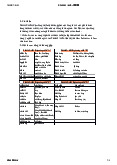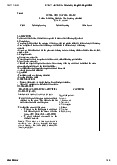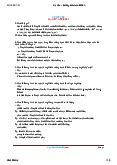







Preview text:
CAMBRIDGE PRIMARY SCIENCE 1: TEACHER’S RESOURCE Learner’s Book answers 1 Living things 1.1 Animals and plants alive! 1.2 Parts of a plant Point to a plant.
Activity 1: Finding plant parts
Answers: The tree, grass, bushes on the horizon, the
Point to a leaf, a flower, the stem and the roots.
plant with the butterfly and the two plants with the
yellow flowers are all plants. Point to an animal. flower
Answers: The squirrel, several birds, bees, butterfly,
frog, rabbits, worms and maggots.
Point to other things that are non-living. stem
Answers: The Sun, rain, clouds, soil, rocks, stones,
the beehive, the sky and the bird’s nest. leaf
Activity: Living or non-living?
Zara is putting things into two groups. roots Where should she put the toy?
Answer: In the non-living group. Look at the non-living things.
Point to some things that used to be alive.
Activity 2: What do the parts do?
Answer: The twig. Some learners might say that the
Make a model of a plant with these parts.
book used to be alive. The book was never alive, but
it is made from something that used to be alive. Say what each part is for.
Point to some things that have never been alive.
Answer: Roots take up water and nutrients from the
soil which travel up the step to other parts of the
Answer: The bottle, the water and the toy bear.
plant. Leaves make food for the plant using sunlight.
The flower or fruit is what enables the plant to reproduce. 1.3 Plants and light
Activity: What do plants need to grow?
What do you think plants need to grow?
Answer: They need water and light and food.
Do plants need food and water like people?
Answer: Yes, but they make their food in their leaves. 1
Cambridge Primary Science – Board & Cross © Cambridge University Press 2021
CAMBRIDGE PRIMARY SCIENCE 1: TEACHER’S RESOURCE
Think like a scientist: What happens to
Activity 1: Grouping loud and quiet a plant with no light? sounds
What will happen to a plant with no light?
Look at the picture. Marcus is using his sense of hearing.
Answer: The plant in the light grows. The plant
covered by the box does not grow.
He can hear loud and quiet sounds. 1.4 Plants need water What are they?
Answer: Loud sounds: radio, school bell, learner
What should the children do to keep this plant
Quiet sounds: clock, tap, page turning alive? Answer: Water the plant
Activity 2: Make sounds louder and quieter
Where do plants get water from? Listen to a sound. Answer: the soil
Now put your hands behind your ears. Activity: Healthy plants Does it change what you hear?
What could we do to help these plants grow?
Answer: it should make it easier to hear
Answer: water them when they need it, give them quiet sounds.
good soil, put them in a sunny place.
How do your hands make things quieter Check your progress and louder?
Answer: they help focus the sounds into 1
The plant is alive. The rock is not alive. your ear.
Learners may also say that the soil is not alive. This is correct. 2.3 Sound moves 2
Learners correctly identify the roots, stem,
leaf and flower in the picture. Can the people hear the man? 3
The plants in the first image need water. The Answer: No
plants in the second photo need light. Why not? 4
The seeds need water and light to grow.
Answer: The people are too far away. Or The man is
not shouting loud enough. The woman cannot hear 2 Sound
the man because her music is too loud.
Think like a scientist: Does sound 2.1 Sound sources changeas it moves?
How many sounds sources can you count in this Who will hear a loud sound? picture?
Answer: The boy nearest the sound source.
Answer: Accept any answer between 12–17 Who will hear a quiet sound?
(including, bird(s), plane, man hammering on roof,
car, cycle, door closing, child playing a whistle, up to
Answer: The boy who is far away from the sound
six people talking, cat) source.
Which sounds sources use electricity? Activity: Near and far sounds
Answer: Mobile phone, radio/portable stereo
How does the sound change as it gets closer?
Answer: The sound gets louder as it gets closer to you. 2.2 Loud and quiet
How can they play the instruments louder?
Answer: Strum/hit/blow/shake harder
How can they play the instruments quieter?
Answer: Strum/hit/blow/shake more softly 2
Cambridge Primary Science – Board & Cross © Cambridge University Press 2021
CAMBRIDGE PRIMARY SCIENCE 1: TEACHER’S RESOURCE Check your progress 3.2 Properties of materials 1
The pictures that contain sound sources are Activity: Using materials
the car, the trumpet, the TV, the mobile phone
Look at the house. What materials can you see? and the aeroplane.
Answer: may include: fabric, metal, wood, glass 2
Correct answers should explain that the girl’s
ears may be damaged by the loud sounds. 3 far away near quieter louder 4
Correct answers should either explain that
Ben could get closer to the radio so the sound Point to some clothes.
is louder or that he could turn up the volume
Answer: in room top left of picture control of the radio.
Clothes are made from fabric. Many fabrics are soft and fl exible. 3 Materials in my world
What would metal clothes be like? 3.1 Different materials
Answer: very uncomfortable.
What other materials have been used?
What materials can you see in the playground?
Answer: may include: fabric, metal, wood, glass
Answer: Made of wood – the bench and the swing frame. What properties do they have?
Made of plastic – the water bottle
Answer: hard, strong (mainly)
Made of metal – the frame of the magnifying glass
Draw something from the picture.
Made of glass – the windows and the lens of the
Write the name of the material. magnifying glass
Write or talk about some properties of
Made of rock – the rocks in the grass the material.
Made of paper – the reading book
Answer: may include hard, soft, dull, shiny, rough, smooth.
Made of fabric – the children’s clothes, the rope
Made of rubber – the tyre 3
Cambridge Primary Science – Board & Cross © Cambridge University Press 2021
CAMBRIDGE PRIMARY SCIENCE 1: TEACHER’S RESOURCE 3.3 Sorting materials 3 Bread roll – twisted Football – squashed
The children are sorting waste materials into groups. Coat hanger – bent What materials can you see?
Large rubber band – stretched
Answer: plastic, fabric, paper, card 4
Which rubber band has stretched the longest? What groups would you make? Rubber band B
Answer: Any group based on materials e.g. a metal
Which rubber band is weak? Rubber band A
group or a paper and card group.
Which rubber band is strong? Rubber band C
Learners might suggest putting different coloured
glass into different groups.
This girl has sorted her materials. 4 The Earth Which materials can you see?
Answer: plastic, metal, card, glass, paper 4.1 Planet Earth
Think like a scientist 1: Sorting
Point to dry land in the picture. materials by observing
Answer: where the picture is brown or green
There are different ways to sort materials.
Point to where water covers the land.
Are these things in the right groups?
Answer: where the picture is blue Answer: Yes
What is the shape of planet Earth in this picture?
Which group does the spoon go in? Answer: a round ball Answer: Hard
Activity 2: You are an astronaut! 3.4 Changing materials
You are writing a science report to say what it is like on planet Earth.
How is this balloon being changed? Complete the sentences below.
Answer: The balloon has been twisted.
Answer: Planet Earth is like a ball. Check your progress
On Earth we have many plants, like trees
and grass, fish and birds. 1 Glass bottle – glass bin
Planet Earth is home to animals, like fish
Metal spoon, fizzy drink can and food can – and birds. metal bin
We have rivers and lakes where we swim.
Plastic yoghurt pot and plastic bottle –
I love to see “trees/grass/birds/fish/people”. plastic bin
(learner’s own answer)
Newspaper and paper plate – paper bin 2
The tyres are made of rubber because it grips
well. Correct – rubber grips well and this is useful for tyres.
The tyres are made of rubber because it is
slippery. Incorrect – rubber is not slippery.
The tyres are made of rubber because it can’t
hurt you. Incorrect – rubber is soft and unlikely
to hurt you but this is not why tyres are made of rubber.
The tyres are made of rubber because rubber
is black. Incorrect – rubber can be made in
different colours and this is not why tyres are made of rubber. 4
Cambridge Primary Science – Board & Cross © Cambridge University Press 2021
CAMBRIDGE PRIMARY SCIENCE 1: TEACHER’S RESOURCE
4.2 Heat and light from the Sun 4.4 Soil
Could you do these things without light from What colour are Earthworms? the Sun? Answer: red/brown Answer: No
What other animals can you see in this picture?
Activity 1: Why do we need the Sun’s
Answer: caterpillar, snail light? What plants can you see?
What would happen to plants without light from Answer: fungus, grass the Sun? Answer: They would die. Check your progress
What would happen to animals without light 1 water covers the land – C from the Sun? land – A Answer: They would die. animals dig in the soil – B 4.3 Rocks 2
The heat from the Sun keeps animals and
Activity: Observing and sorting rocks plants warm.
White or rocks you can see through – quartz,
Without the Sun’s light plants would not grow. diamond, chalk 3 wall, path, building, rockery Grey rocks – slate 4
living thing – worm, ant, beetle, caterpillar,
Red rocks – granite, sandstone centipede
Think like a scientist 1: Making rocks dead thing – bone, leaf wet rock – point to any
Point to the part of this rock that is wet.
How will the rocks look after getting wet? 5 Humans Answer: shiny 5.1 Our bodies
How will the rocks will feel after getting wet? Answer: cold and damp How many legs do you have? How does the rock change? Answer: 2
Answer: it gets shiny and colours are clearer How many fingers do you have? How does it look? Answer: 10
Answer: it gets shiny and colours are clearer
What other body parts can you name? How does it feel?
Answer: Any correctly named external or internal body parts. Answer: cold and damp
Which part of the body is the most important?
Why does she need dry rock to climb? Is it the head?
Answer: She can grip the rock better when it is dry. 5
Cambridge Primary Science – Board & Cross © Cambridge University Press 2021
CAMBRIDGE PRIMARY SCIENCE 1: TEACHER’S RESOURCE
Answer: There is no correct answer to this question.
The other thing he needs to stay alive is air
There are many parts of the body that you cannot to breathe.
live without, the brain, heart, lungs, spinal chord,
etc. All of these might could be considered equally
Activity: What would you take to the
important. Learners may suggest external parts of stars?
the body from this topic, or internal parts such as the
Sofia, Zara and Arun are going to the stars.
brain, heart or lungs that have not been introduced
yet. Some learners might say that the brain is inside
Fluffy the rabbit is going, too.
the head and the brain controls everything, so the
What do they need to take with them to stay
head is the most important body part. Other learners alive?
may suggest that the heart is the most important part of the body.
Answer: healthy food, fruit and vegetables and water to drink, air to breathe. Activity: Parts of the body
What other labels could you have on the Check your progress drawing? 1
Learners should point to the correct part of
Answer: any part not yet labelled, such as elbow, the body in the picture. knee, nose, eyes 2 Lina can hear with her ears. 5.2 Our amazing senses She can taste with her mouth. Getting started She can touch with her skin. What are our senses? She can smell with her nose.
Answer: sight, hearing, touch, small, taste 3
How many learners had black hair? Five
Think like a scientist: What can you How many had blond hair? One smell? How many had ginger hair? Four
Were Arun’s predictions right?
How many learners were there altogether? Ten
Answer: coffee and chocolate correct but 4
The lunch box on the left is healthier because lemon wrong
it contains fresh fruit, brown bread, salad and
water. The lunch box on the right contains 5.3 Similar and different
white bread, which is less healthy than brown
bread, chocolate and a cake that contains
In what other ways are they are similar?
sugar and fat and a sugary fizzy drink.
Answer: all have same number of legs and arms, 5
The foods that are healthy are the rice, the nose, mouth, ears
pineapple, the kiwi fruit, the sweetcorn, the
orange, the apple, the chicken, the lettuce in
In what other ways are they are different? the burger and the fish.
Answer: some wear glasses, some don’t, different
The unhealthy foods are the sugary fizzy colour skin
drink, the butter, the cream, the sugar, the
jam, the chocolate, the burger (apart from 5.4 Staying alive
the lettuce), the chips and the salt. Getting started
Which things does Marcus need to stay alive?
Answer: To stay alive, Marcus needs healthy food,
fruit and vegetables and water to drink.
To stay alive, he does not need sugary fizzy drink,
unhealthy food such as chocolate, cake and sweets, or toys books or games. 6
Cambridge Primary Science – Board & Cross © Cambridge University Press 2021
CAMBRIDGE PRIMARY SCIENCE 1: TEACHER’S RESOURCE 6 Forces 6.3 Making things move
Activity 1: Let’s see the force of the 6.1 Moving things push
Look at the picture and how things move.
Does the balloon help to show the push? How do the children move?
Answer: Yes it does help because as you push on
the balloon it changes shape, the more you push the
Answer: dancing, skipping, leapfrogging, jumping more it changes shape. How does the ball move? 6.4 Floating and sinking
Answer: flies through air, bounce, roll How does the rope move?
Look at the picture. What things sink?
Answer: up and down, side to side
Answer: key, billiard ball, modelling clap, apple, baseball, cup Activity 1: Moving toys Activity 2: Make it float!
Observe these toys and say how they move.
Will this ball of clay sink or float?
Answer: the train rolls, the windmill spins, the boat Answer: it will sink
floats, the paper aeroplane glides (accept other suitable descriptions) Which new shape floats? Now look at other toys.
Answer: If it is thin and flat, the clay will float. Observe them carefully.
Think like a scientist: Air helps How do they move? thingsfloat
Answers: will be describing movement, for example,
The balloon, beach ball, football and plastic bottle
forward, backwards, fast, slow, turning, going
half full of water should float.
straight, going around corners, spinning, rolling,
The plastic bottle almost full of water should sink. turning, etc.
What do you notice about the ways that different
How many children could pull a plane? things float?
Answer: any number from 30–200 can be considered
Answer: things with air inside them float. a sensible answer.
What other machines push and pull to make
Do you think that air helps them float? things move? Answer: yes
Answer: Accept any suitable answers, such as a
locomotive engine (train), lorry tractor unit, drill, hammer, etc. Moving in space can be hard. How is this astronaut moving?
Answer: Words to describe her movement
e.g. floating, turning, pushing, pulling, spinning, etc. 6.2 Push and pull forces
How could the children pull and push with more force?
Answer: push or pull harder. Ask someone to help. How could another child help?
Answer: Another child could push or pull to help. 7
Cambridge Primary Science – Board & Cross © Cambridge University Press 2021
CAMBRIDGE PRIMARY SCIENCE 1: TEACHER’S RESOURCE 6.5 Magnets can pull 3
turning or dancing; riding in a carriage; swinging, on wheels.
Think like a scientist: Which materials 4 round and round or up and down are magnetic? 5 key – sink Try to see a pattern. balloon – float
Answer: You may notice that magnetic materials are beach ball – float
always metals (not all metals are magnetic.). rock – sink Sunil is testing his magnets. 6
The nails are drawn attached to the magnet.
They are attracted to the fridge door. Why?
Answer: it is made of metal
They are not attracted to the wooden door. Why not?
Answer: wood is not magnetic Check your progress 1 pushing 2 swinging or to and fro 8
Cambridge Primary Science – Board & Cross © Cambridge University Press 2021




